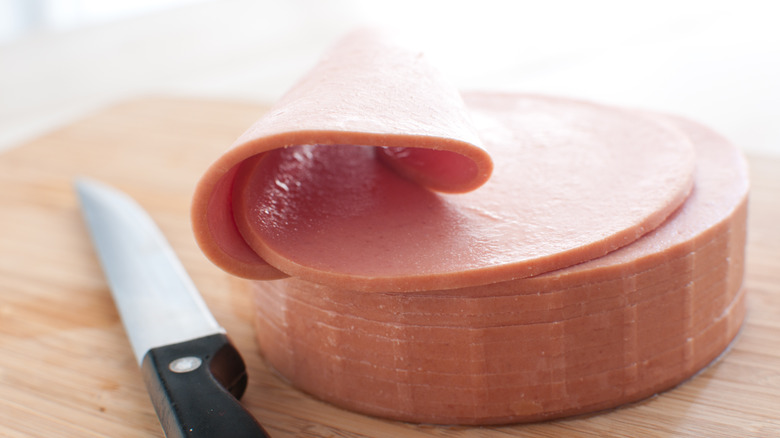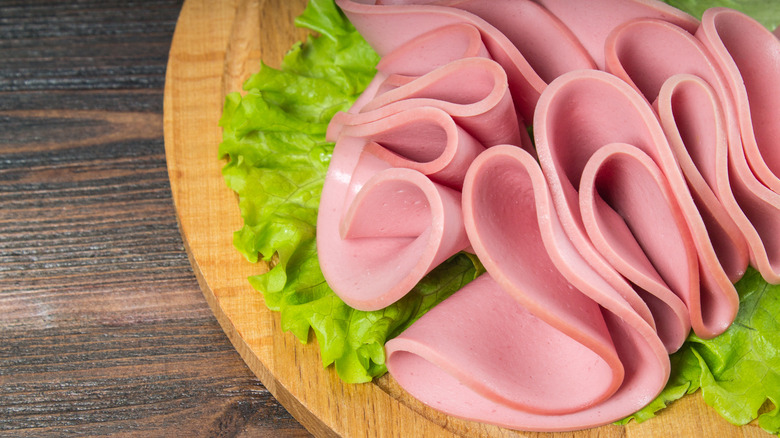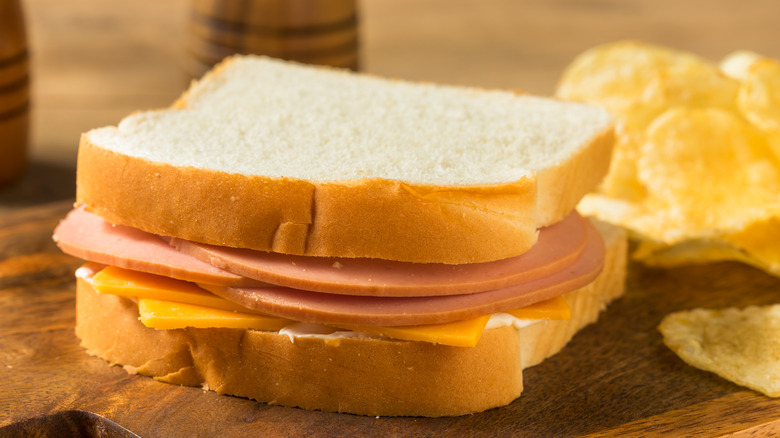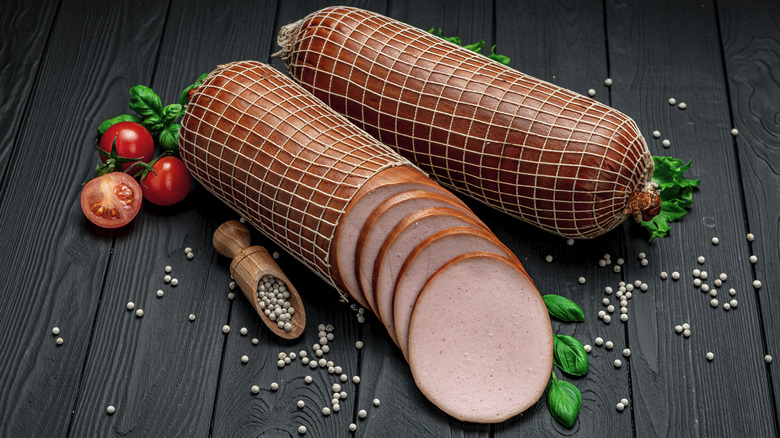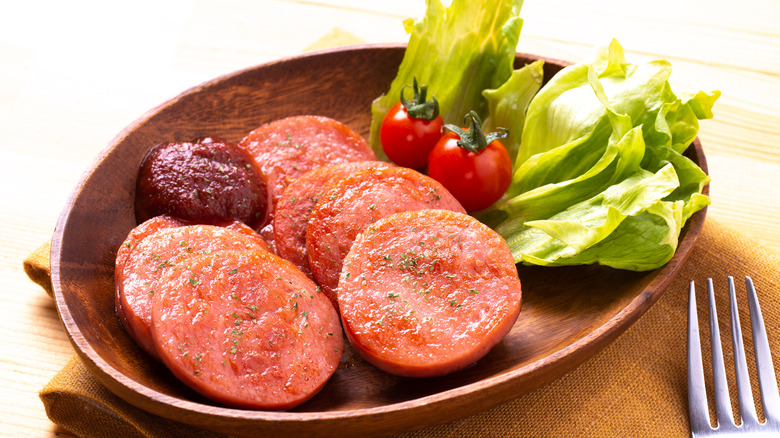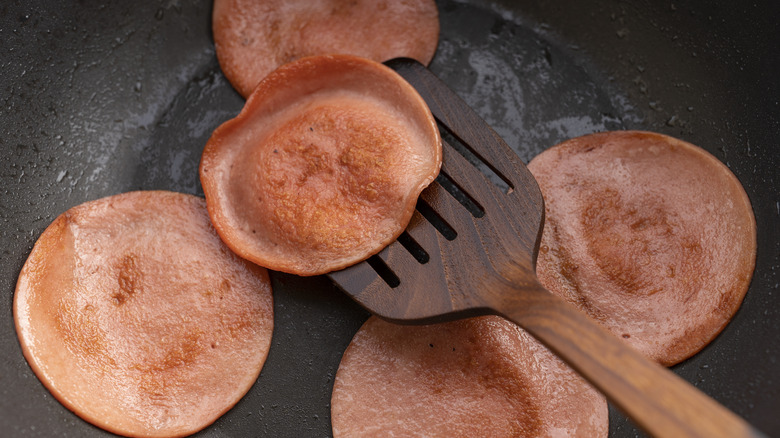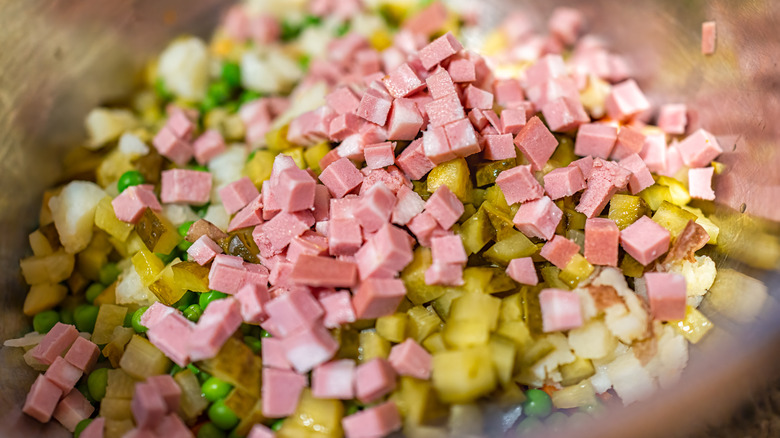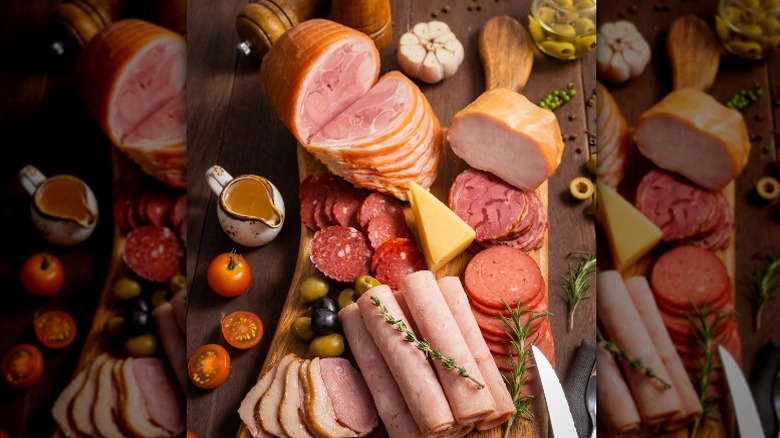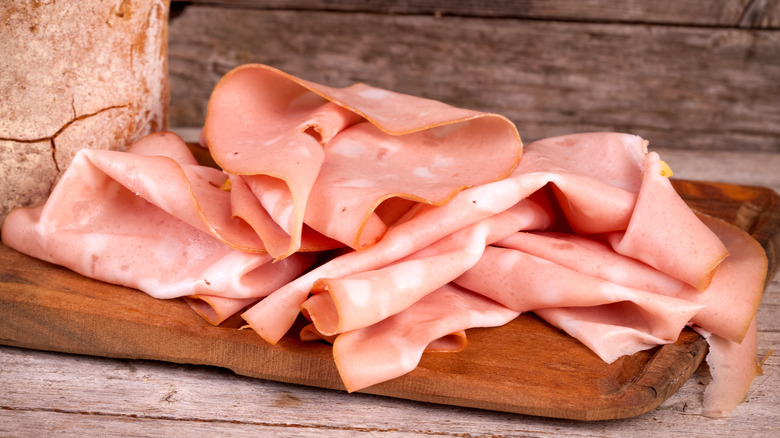Mistakes Everyone Makes With Bologna
Bologna is a class of deli meat that seems to be known as either the butt of a joke or a marker of childhood nostalgia. It's not often that you find yourself going over to an adult friend's house for lunch to be served bologna sandwiches. The mystery meat has found a bit of redemption on the restaurant scene in recent years thanks to a number of chefs using it in inventive ways, but otherwise, it's typically a forgotten food.
In this day and age, bologna doesn't make it on to as many shopping lists as it used to. However, that doesn't mean you should be overlooking it. Bologna is an ingredient in and of itself that deserves basic respect. There is so much more to it than throwing it between two slices of white bread and sticking it into a lunchbox without a second thought. The thing about bologna is that lots of people simply don't know how to make the most of it.
Here are some big mistakes that everyone seems to make when it comes to bologna. Hopefully, it will inspire you to pick up a pound on your next grocery run and get creative with the nostalgic lunchmeat.
Thinking too hard about how bologna is made
The origin of bologna being the butt of food jokes lies in its reputation as a so-called "mystery meat." The average person has likely never put much genuine thought into how bologna is made, but that doesn't stop them from making jokes about not wanting to know what's inside. The process, as defined by the USDA, falls under the same umbrella as hot dogs and other cooked/smoked sausage products, but those foods don't come with the same stigma. Bologna slices are basically flat hot dogs, but what actually goes into them?
Bologna can be made from cured beef, chicken, or pork. Commonly, it's some combination of those three meats. Some are made from premium cuts while others utilize byproduct meat, like organs and trimmings, even though the latter is not as popular these days. The meat is ground very finely into a smooth batter before being pressed into casings like a hot dog. Usually, bologna contains a substantial portion of fat, meat, and water, but it also typically features spices like garlic, nutmeg, allspice, celery seed, and myrtle berry.
Sure, it's not the most appetizing process to think about before you sit down to eat, but you could gross yourself out about almost anything if you think too hard about how it ended up on your plate.
Forgetting to mix up toppings on bologna sandwiches
The humble bologna sandwich is a staple in packed lunches across the United States and has been for decades. Oftentimes, a bologna sandwich will be a slapped-together combination of white bread, bologna, and a condiment like ketchup or mayonnaise. Some people might throw in pickles or a slice of cheese, but that's not even common practice unless it's a fried bologna sandwich. A bologna sandwich is only as good as you make it, and if you make it boring, well, you can guess what happens next.
There are plenty of ways to mix-up the standard bologna sandwich. Swap out the regular bread slices for something different like sourdough or even a toasted bagel. The bologna will also be better if you fry it on the griddle a little bit to bring out the flavor. From there, your imagination is the only thing holding you back. The popular New Orleans restaurant Turkey and the Wolf serves a griddle-fried bologna sandwich with American cheese, hot mustard, Duke's mayo, shredded lettuce, and vinegar potato chips stacked between two slices of buttered bread. Nothing boring about that, right?
But what if you don't have a bunch of other ingredients to hand? Well, chef and television personality Alton Brown suggests making a sandwich that is a combination of fried bologna and cold bologna right out of the fridge. The different textures and flavors shine through the simple sandwich, meaning that it only needs a little mayonnaise, mustard, and perhaps a little red onion to make it pop.
Treating bologna like a low class meat
Bologna is often thought of as a last resort option when it comes to lunchmeat. Sure, you might scoff down a bologna sandwich if it's served to you, and you might well get some enjoyment out of it, but it probably wasn't your first choice for lunch and it probably won't be next time, either. However, if you think outside of the sandwich, you can transform bologna into a meat that's just as delicious as those pricier cuts at the butcher's counter.
If you're interested in transforming your bologna into something a bit more fancy, you could always do what Grillin' Fools does and make "burnt ends" out of thick dices of bologna. Usually, burnt ends are made by overcooking pieces of beef brisket until they are extremely tender. The recipe suggests slathering chunks of more affordable bologna meat in butter, barbeque sauce, and honey, and then smoking them twice to get a similar effect to brisket. It might even inspire you to make your own bologna at home with a meat grinder and a backyard smoker.
Forgetting to fry your bologna
The most foolproof way to change a bologna hater's mind about the meat is to fry it. Bologna has a soft texture that doesn't resemble any other meats (aside from its cousins like hot dogs and Spam). The mouthfeel can be a little unsettling for picky eaters, which is why frying it is the way to go. As one Quora user pointed out, eating bologna that isn't fried is pretty much the same as eating a cold hot dog that wasn't boiled or grilled. It's just not that appetizing.
The heat from a grill helps to caramelize the sugars in the bologna meat, amping up the sweetness. It also adds variety in texture by having the soft interior complemented with a crispy exterior. "It's almost like an oxymoron," Redditor u/drainspout wrote of fried bologna. "Bologna is supposed to be looked down upon, but when you fry it... it becomes a whole new thing that is superior!"
We recommend making this gourmet fried bologna sandwich for that person in your life who loves to insult bologna. They'll be eating their words before they've even finished eating the sandwich.
Failing to evenly fry bologna slices
Okay, once you've stopped making the mistake of forgetting to griddle bologna before you eat it, it's time to learn the proper way to fry your bologna slices. The meat caramelizes and browns so nicely, but due to the lack of density, it's easy for bologna slices to curl while cooking. This can lead to unevenly cooked slices that are difficult to pile onto a sandwich. Thankfully, the internet exists and there's a bunch of different guides on how to evenly fry bologna slices online.
It's vital that you learn how to evenly fry your slices or you run the risk of thinking the whole fried bologna thing is just a lot of fuss about nothing. Katie Lee from Food Network's "The Kitchen" learned a fool proof way of frying bologna from her grandfather. It's very effective, and, thankfully, very simple: She just takes the uncooked slice of bologna and adds slits in the shape of an "X" in the center. This small step helps each slice cook evenly. It's going to taste better and it's going to be way easier to stack in a sandwich.
Overlooking the bologna salad
Bologna sandwiches may be the most common way to enjoy what has to be the world's most-mocked meat, but that's only because most people have never experienced the balanced flavor of bologna salad. Like a seafood salad or a chicken salad, a bologna salad doesn't really resemble a "salad" at all. Rather, it features chopped up pieces of bologna with other ingredients that are held together by some sort of dressing. The "dressing" in this case is typically mayonnaise or a mayo-based product.
Besides bologna and mayonnaise, the ingredients in bologna salad — which is popular in the Midwest, where restaurants have started taking the meat seriously — are really up to the chef. Usually, it features a few chopped up vegetables like bell peppers, onions, or celery, as well as fresh herbs like parsley and dill. Some people like to add chopped pickles, hard boiled eggs, and even fruit juice to their salads, according to a discussion on Reddit. "Secret ingredient: a splash of pineapple juice," u/StyleBear4Life said. Fellow user u/MrsData chimed in to say that their husband had become totally obsessed with bologna salad since trying it. "He insists that it is the best thing ever."
Storing bologna with raw meat
Like ham, salami, and other cured meats, bologna is pretty easy to find at the grocery store. When you get home, you might just throw it in your fridge's meat drawer without a second thought, but this is a common mistake people make with bologna. As pointed out by the FDA, it can be easy to overlook how you are handling cooked meat in relation to raw meats.
It's important to remember that whenever you buy bologna, you should keep it totally separate from any raw meats, even in your supermarket cart. It should be put into a different shopping bag and stored in a different area of your refrigerator to prevent any accidental contamination.
If you're dealing with both bologna and raw meat at the same time while cooking, you should make sure to use different cutting boards and knives. The last thing that bologna's reputation needs is the stigma that it will give you food poisoning. That's only true based on user error, so it's important to know the food safety basics.
Thinking that bologna and mortadella are the same
Bologna is an American staple at grocery stores, but, as you might expect from its name, it actually has roots in Italy. Well, sort of. Bologna is the Americanized version of Mortadella, a similar deli meat that originates near the northern Italian city of Bologna. Mortadella and bologna are not the same, though, which is a common misconception among those who aren't in the know when it comes to deli meats.
Bologna can be made out of chicken, pork, and/or beef, while Mortadella must be made out of pork and pork alone. This has been a qualification since the 1600s, so Mortadella is solidified in its distinct identity. Mortadella is usually made using a similar method to bologna, but it's common to see large pieces of ingredients like pistachios, olives, and peppercorns inside each slice, unlike a uniform piece of bologna. While they aren't exactly the same, it is probable that if you like one, you'll enjoy the other.
